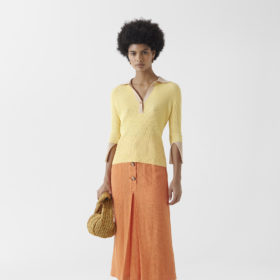London-based Designer Rejina Pyo on Sustainability and Unisex Style
Since launching her line in 2014, London-based designer Rejina Pyo has become a favourite on the city’s fashion week calendar and a beloved presence in the wardrobes of the world’s savviest style mavens. We caught up with her for FASHION’s April issue to talk about how she became interested in design, her brand’s approach to sustainability, and the creatives who inspire her artful pieces.
What was your relationship with style growing up?
My mom was a fashion designer when she was in her 20s. She has a wonderful sense of style, and she took great joy in dressing me. We always had fabrics lying around the house; she’d make everything from curtains to my clothes, so the concept of making things was always around me. I asked her to teach me how to sew, and I made my first dress when I was 12. She had an old school sketchbook with drawings of Peter Pan collars and bell sleeves. I thought it was the most beautiful thing, and I would try to draw the same way she did. But she didn’t want me to pursue fashion, so she would hide the book. [Laughs] I was also inspired by television shows with traditional Korean clothing called ‘hanbok’; it’s very colourful and has lots of layers — it’s very interesting. Any time something like a period drama came on, nobody could change the channel because I was guarding the TV.

Tell us about the brand’s philosophy and its sustainability journey.
I’ve always felt bad about fashion being one of the most polluting industries, and that people don’t care about how a piece of clothing can be so cheap. It really bothers me. And there’s also been a trend of people buying things that they don’t actually wear many times, like buying things just to wear to go out at night. I felt like women didn’t have a lot of choice in terms of having nice clothes to wear to work — pieces that aren’t one-off, showy fashion, but that give the wearer a sense of enjoyment and comfort as they go about their daily routine. Expressing yourself is good, but if people have to suffer wearing it…I don’t think that’s right. And women have been objectified throughout history, so it’s the right time for us to now dress for ourselves and not for other people.
Whenever I’d start to feel very bad about all these things, I’d have conversations with my good friend, who’s now the brand’s managing director; she’s an expert in fashion sustainability. She’d say that I shouldn’t walk away, but be in this [industry] to make valuable changes.
You can’t do things overnight — it takes so long to research certifications for biodegradability, for example, or what a recycled fabric is actually made of. Now that sustainability is such a trend, some people will try to scam you. We have a pyramid metric for materials that we use, and each season we monitor the sustainability rating of fabrics so we have a practical goal instead of just saying, oh, let’s be sustainable.
We’ve also opted out of making huge sets for our fashion shows because we know those are thrown away straight after, and have rethought how we made invitations for [fashion week]. For Spring 2020, we used old library cards and had the show in a library to show off its beautiful architecture. And for our most recent show we opted out of sending physical invites and instead sent an e-vite.
Did you miss doing fashion week last year?
I didn’t miss it as much as I thought I would. It was nice to spend time with our team and talk about different ideas. You can’t really do that when you’re in the cycle of fashion week. A lot of things are last minute during that time, and you’re bound to be working until 1 or 2 a.m. That gives you excitement and hype, but now there’s a different approach. Since COVID, there’s been a conversation in the industry about how we can make things better — especially for the environment. That’s fresh and welcoming for me.

Why did you decide to create unisex garments?
I’ve always been interested in the life aspect of fashion. I was seeing people, including myself and the girls in my office, wearing men’s clothing, and it gave me an idea — why don’t we just share clothes? Retail buyers were confused about where to put these pieces in their stores because genders are separated, but I think we’ll get there in the end and I believe in the idea. It’s nice to have one piece of clothing that one day you can wear and the next day, your partner could wear it — you get more use out of it.
View this post on Instagram
Which artists have been most influential to you in terms of your designs?
I love fine art, and I often joke that when I retire at 65, I’ll be painting and making sculptures. I generally like very organic, abstract work from artists like Isamu Noguchi and Constantin Brancusi. But I’ve also discovered a lot of female artists like Georgia O’Keeffe and Angela de la Cruz. Angela explores the boundary between 2-D and 3-D and makes sculptural pieces out of canvas. They’re so beautiful. She had a stroke years ago, so she’s not able to do them herself now, but it’s so inspiring to see her working with her team to articulate her ideas. And Helen Frankenthaler’s colours are so beautiful…. It’s an endless list.
The post London-Based Designer Rejina Pyo on Sustainability and Unisex Style appeared first on FASHION Magazine.